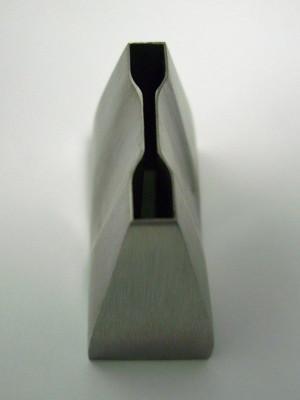Jump to a section:
Load cell – The amount of force that is applied to the specimen, as measured by the loadcell. We are currently equipped with 2 load cells: 1 kN and 10 kN.
Cell limits: maximum capacities of the cell for safety purposes or defining points of failure
- Maximum capacity: the maximum force to which a load cell can consistently be loaded safely
- Select a load cell where the peak load experienced during testing fulls under approx. 80 – 90% of the load cell’s maximum capacity.
- 1 kN = 800 – 900 N maximum
- 10 kN = 8 – 9 kN maximum
- Consider the accuracy rating. The load cell accuracy’s are generally 0.01%.
- 1 kN = 10 N minimum
- 10 kN = 100 N minimum
- Overload capacity: a built-in safety factor to which the load cell can be loaded without damage
- Mechanical failure: maximum force the load cell can experience without mechanical damage
- Tare weight: a percent of full-scale capacity indicating the maximum weight that can be zeroed out while still allowing use of the full-scale capacity of the load cell
- Using fixturing that exceeds a load cell’s tare weight runs a high risk of overloading and damaging the load cell.
Sample and clamping
While the tensile tester is better equipped for large samples, dogbones (center section narrower than the ends) of 40 mm can be accommodated. Material can be cut into the proper dimensions using a cutting die, such as the one pictured below, or by molding.

Wedge-action, self-tightening clamp – Material is clamped between the grips. By making the ends wider than the middle, breakages are more likely to occur in the middle rather than the ends. When a breakage occurs in the midsection, it is attributed to the material’s tensile strength. When a breakage occurs on the ends or in the clamps themselves, it is attributed to material defects or improper loading. As the instrument pulls the material, the clamps pneumatically compresses so the material does not slip out of the grips.
- Tensile modulus: ratio of stress to strain below the proportional limit of the material
- Toughness: total area under a stress-strain curve and a measure of the amount of energy required to break the specimen
Three-point bending clamp – Most common for flexual tests. The material is placed between two supports and the load is applied to the center at a specified rate.
- Tensile and compressive stresses
- For thermoplastics that do not break during this test, flexural stress at 5% strain is calculated-the loading needed to stretch the outer surface 5%.